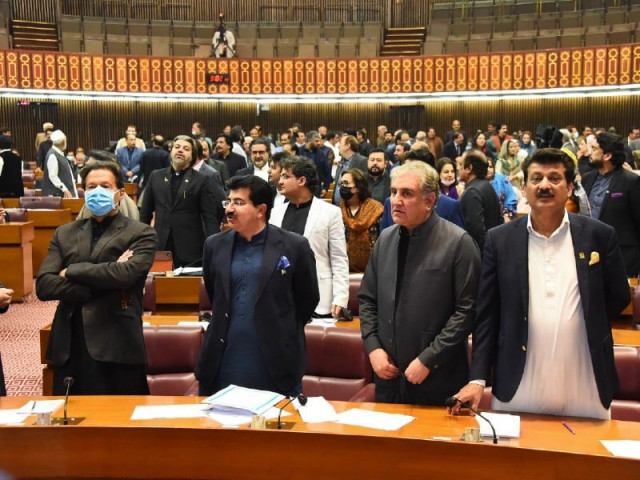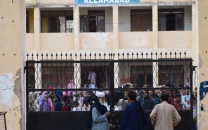Fateful session to take place amid looming threat of clash
Roads leading to Red Zone blocked to bar protestors from entering it

The National Assembly will go to vote on Sunday (today) to decide the fate of Prime Minister Imran's government amid a looming threat of political heat tipping over into a full-blown clash.
Apparently, the joint opposition parties have more lawmakers on their side after the ruling party’s numerical strength evaporated following the decision of its key allies to side with the opposition.
Nevertheless, the embattled prime minister remains sanguine about his prospects, insisting that he will turn the tables on the opposition at the last minute. On the eve of the fateful session, PM Imran walked back on his earlier directions to his party members to not attend the fateful session and allowed them to attend it. The premier also urged the masses to stage peaceful protests against “traitors”.
At a time of already profound political polarisation around extremely sensitive issues, the open calls for protests against the “traitors” and stoking fears about a “foreign conspiracy” may prove to be a potential recipe for chaos and mayhem – Pakistan’s own Capitol Hill moment.
Political observers have expressed fears that PM Imran’s supporters might manage to break into the Red Zone and besiege the Parliament building, leading to a volatile situation. In order to keep the Red Zone secure and bar protestors from entering it, the capital’s administration has blocked all the roads leading to Red Zone.
The authorities have also decided to deploy roughly 8,000 police Rangers and Frontier Constabulary (FC) officials to avert the rallies, if any, from entering the sensitive area and besieging the parliament. The traffic police also issued a traffic plan, according to which only Margalla Road would be opened for traffic to enter into Red Zone.
Apart from resorting to name-calling, labelling the other side as traitors and alleging that the opposition parties’ no-confidence motion was being backed by foreign powers, PM Imran has also filed a petition in the Supreme Court seeking a lifetime electoral ban on the lawmakers who abandoned him at this crucial moment.
How does a no-confidence vote work?
Out of the total 342 members of the assembly, a prime minister is elected if he/she secures 172 or more votes. The premier would continue if the opposition fails to produce 172 or more lawmakers in the assembly for any reason.
READ ‘Confident’ Imran assures PTI lawmakers of victory in no-trust vote
If PM Khan loses the vote, parliament would continue to function and the lawmakers in the National Assembly will elect a new prime minister to serve until August 2023, after which a general election is due within 60 days. However, the new premier can go for early elections before August 2023. Though the opposition parties have shown their strength in the assembly in the previous session and insisted on voting on the motion without having the support of PTI’s disgruntled members, the deputy speaker had adjourned the session for April 3 – Sunday at 11:30am.
Under clause (2) of Article 95 (vote of no-confidence against Prime Minister) of the Constitution, “a resolution referred to in clause (1) shall not be voted upon before the expiration of three days, or later than seven days, from the day on which such resolution is moved in the National Assembly.” Clause (4) of Article 95 adds that “If the resolution referred to in clause (1) is passed by a majority of the total membership of the National Assembly, the Prime Minister shall cease to hold office.”
Rule 37 (6) (Resolution for a vote of no-confidence against the Prime Minister) of Procedure and Conduct of Business in the National Assembly, 2007, also state that “the resolution shall not be voted upon before the expiry of three days, or later than seven days, from the day on which the resolution is moved in the Assembly.”
Voting procedure
The Second Schedule of the NA rules defines the procedure for recording votes. Before voting commences, it states, that the speaker shall direct that the bells be rung for five minutes to enable members not present in the chamber to be present. Immediately after the bells stop ringing, all the entrances to the Lobby shall be locked and the Assembly staff posted at each entrance shall not allow any entry or exit through those entrances until the voting has concluded.
It adds that, "the Speaker shall then read out the resolution before the assembly and ask the members who wish to vote in favour of the resolution to pass in single file through the entrance where tellers shall be posted to record the votes. On reaching the desk of the tellers, each member shall, in turn, call out the division number allotted to him under the rules.
The tellers shall then mark off his number on the division list simultaneously calling out the name of the member. In order to ensure that his vote has been properly recorded, the member shall not move off until he has clearly heard the teller call out his name. After a member has recorded his vote, he shall not return to the Chamber until bells are rung under paragraph 3.
"When the Speaker finds that all the members who wished to vote have recorded their votes, he shall announce that the voting has concluded. Thereupon the Secretary shall cause the division list to be collected, count the recorded votes and present the result of the count to the Speaker.
The Speaker shall then direct that the bells be rung for two minutes to enable the members to return to the Chamber. After the bells stop ringing, the Speaker shall announce the result to the Assembly," it adds.



















COMMENTS
Comments are moderated and generally will be posted if they are on-topic and not abusive.
For more information, please see our Comments FAQ